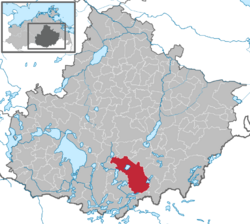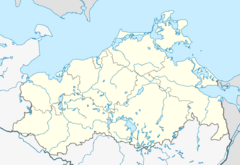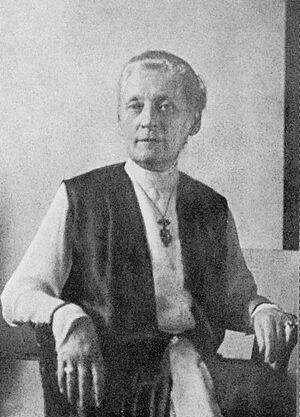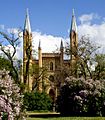Neustrelitz facts for kids
Quick facts for kids
Neustrelitz
Niegenstrelitz (Low German)
|
||
|---|---|---|
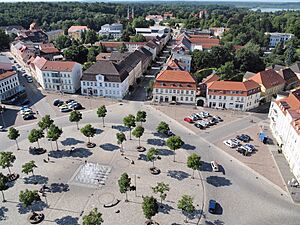
View over Neustrelitz market
|
||
|
||
| Country | Germany | |
| State | Mecklenburg-Vorpommern | |
| District | Mecklenburgische Seenplatte | |
| Subdivisions | 13 districts | |
| Area | ||
| • Total | 138.15 km2 (53.34 sq mi) | |
| Elevation | 75 m (246 ft) | |
| Population
(2022-12-31)
|
||
| • Total | 20,340 | |
| • Density | 147.23/km2 (381.33/sq mi) | |
| Time zone | UTC+01:00 (CET) | |
| • Summer (DST) | UTC+02:00 (CEST) | |
| Postal codes |
17235
|
|
| Dialling codes | 03981 | |
| Vehicle registration | MST | |
| Website | www.neustrelitz.de | |
Neustrelitz (pronounced noy-SHTRAY-lits) is a town in Germany. It's located in the state of Mecklenburg-Vorpommern, right by the beautiful Zierker See (Lake Zierke). This area is known as the Mecklenburg Lake District, famous for its many lakes.
The town's name, Strelitz, comes from an old Slavic word, Strelci. This word means "archers" or "shooters".
Contents
A Glimpse into Neustrelitz's Past
The original village of Strelitz was first mentioned way back in 1278. Over the centuries, it grew into a small town.
How Neustrelitz Was Born
In 1712, a big fire destroyed the old castle and town of Strelitz. After this disaster, the duke and his family moved to their hunting lodge. This lodge was by the Zierker See, a lake northwest of the old town.
A brand new town was built around this lodge. It was named Neustrelitz, which means "New Strelitz". In 1736, Neustrelitz officially became the capital of the Duchy of Mecklenburg-Strelitz. It remained an important ducal seat until 1918. The old town of Strelitz still existed as a small village, but it became part of Neustrelitz in 1931.
Cool Places to See in Neustrelitz
The center of Neustrelitz has many buildings with a special style called Baroque architecture.
The Heart of the City: Market Square
The main spot in town is the Marktplatz (Market Square). Here you'll find the Stadtkirche (city church), which was built between 1768 and 1778. Across from it is the Rathaus (Town Hall), built in 1841.
Palace Gardens and Historic Buildings
The old Neustrelitz Palace was sadly destroyed in 1945. However, its beautiful palace gardens (Schloßgarten) are still there!
When you visit the gardens, look out for these cool spots:
- The Orangerie: This 18th-century building was once a summerhouse.
- The Schloßkirche (Palace Church): Built between 1855 and 1859, it has a unique English Neo-Gothic style.
- The Hebe Temple: This Neoclassic temple has a copy of a statue of the goddess Hebe.
- The Louise Temple: Built in 1891, this temple looks like an ancient Greek temple. It holds the tomb of Queen Louise of Prussia, who was born a princess of Mecklenburg-Strelitz.
There's also a small lake called Glambeck See. In summer, you can swim in a safe area and enjoy lunch at a restaurant overlooking the water.
Getting Around Neustrelitz
The town has a train station on the Berlin Northern railway. This means you can easily travel to and from big cities like Berlin and Rostock.
Fun Things to Do in Neustrelitz
Neustrelitz offers some exciting entertainment options!
Immergut Festival
Since the year 2000, the city has hosted the popular Immergut Festival. Almost 5,000 visitors come each year to enjoy the music and atmosphere.
Local Theatre
Neustrelitz is proud to have its very own theatre. It has a group of actors who live and perform there all the time. You can often see plays, operas, and musicals. The theatre can seat up to 400 people.
Famous People from Neustrelitz
Many interesting people have come from Neustrelitz.
-
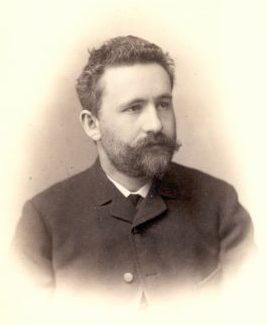 Emil Kraepelin, a famous psychiatrist
Emil Kraepelin, a famous psychiatrist - Albert Wolff (1814–1892), a talented sculptor.
- Emil Kraepelin (1856–1926), a very important psychiatrist. He is often called the father of modern psychiatry.
- Marie Kundt (1870–1932), a photographer, teacher, and director at a famous school in Berlin.
- Andreas Dittmer (born 1972), an amazing canoeist who won three Olympic gold medals!
- Charly Hübner (born 1972), a well-known actor.
Neustrelitz and Other Cities
Neustrelitz is "twinned" with several cities around the world. This means they have special friendly relationships and often share ideas and cultures.
Sister Cities
Neustrelitz is twinned with:
 Chaykovsky, Russia
Chaykovsky, Russia Szczecinek, Poland
Szczecinek, Poland Rovaniemi, Finland
Rovaniemi, Finland Schwäbisch Hall, Germany
Schwäbisch Hall, Germany
Images for kids
-
Franco-Prussian War memorial in Strelitz-Alt
See also
 In Spanish: Neustrelitz para niños
In Spanish: Neustrelitz para niños



